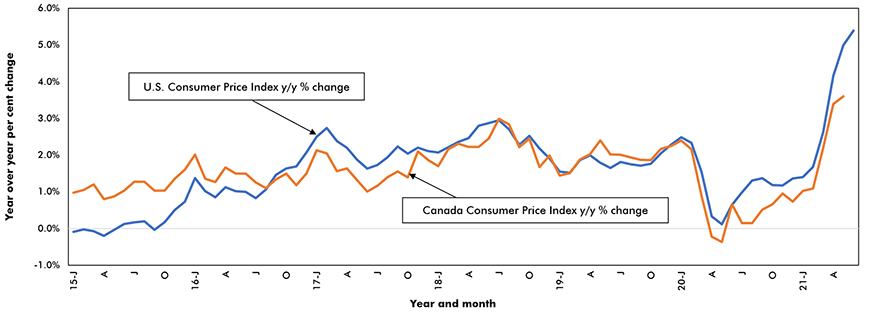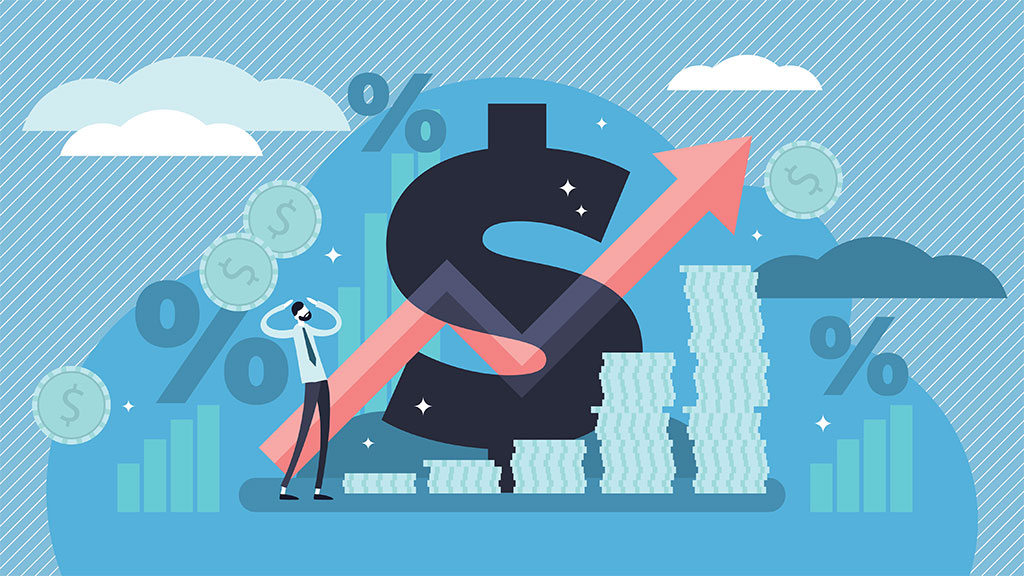Given that the Canadian and United States economies are joined at the hip, it is not surprising the pattern of inflation in the two countries is very similar (see chart below). Most recently, the key drivers of inflation in both countries have been energy and motor vehicles. Their prices were depressed by COVID-19 lockdowns in April and May of 2020, but they have seen sharp accelerations since then. While those two price components are largely responsible for pushing headline inflation to a ten-year high of +3.6% y/y in Canada and a 13-year high of +5.4% in the United States, core inflation has also increased significantly in both countries.
Central banks consider recent inflation uptick “temporary”
In its just-released July Monetary Policy Report, the Bank of Canada (BoC) noted that higher gasoline prices and ongoing supply bottlenecks were likely to cause “inflation to remain above 3% through the second half of this year (2021) and ease back towards 2% in 2022”. A similar inflation outlook was recently voiced by the U.S. Federal Reserve (the Fed). It reported that “shortages of material inputs and difficulties in hiring have held down activity in several industries” and fueled a temporary surge in inflation.
Canadian and U.S. monetary authorities consider their respective economies to have considerable excess capacity which requires them to keep interest rates as close to zero as they can. They plan to maintain this policy stance until the slack in the economy is absorbed and the +2% inflation target is sustainably achieved.
BoC & Fed see inflation back to 2% in 12 to 18 months
The BoC and the Fed contend that the recent acceleration in prices will prove to be temporary and, as the mismatch between supply and demand fades, inflation will ease over the next 12 to 18 months. However, several forward-looking indicators suggest otherwise. First, against a background of very expansionary monetary policy (i.e., interest rates are effectively zero in both countries), governments on both sides of the border are providing an extremely large amount of fiscal stimulus.
In Canada, private sector hiring has increased by 25% over the past 14 months while in the U.S., firms have increased their payrolls by 14% over the same period. Record-high job vacancy rates in Canada and the U.S. suggest both economies may be closer to full capacity than monetary authorities currently believe.
Cdn and U.S. surveys show increase in inflation expectations
The surge in labour demand in Canada has not yet had a significant impact on wages. That said, the 07/2021 reported that expectations of faster wage growth hit a record high in the second quarter. Part of the increase will be due to firms “catching up” after no change in 2020. Other factors include a greater need to attract and retain skilled workers and recent bumps in the cost of living.
The BOS also reported that, while most firms expect inflation to remain between 1% and 3%, the percentage of respondents expecting inflation above 3% over the next two years has jumped from 1% in Q2/2020 to 35% in Q2/2021. Private sector surveys which report a similar increase in inflationary expectations include the Canadian Federation of Independent Business (CFIB)’s Business Barometer which reported that firms now (in June) expect their average prices over the next year to increase by +3.5% y/y compared to less than +1.8% y/y in June 2020. Also, reflecting upward pressure on prices, the IVEY Purchasing Managers Price Index posted a +46% y/y gain in June, its largest jump on record.
In the United States, the Federal Reserve Board’s Beige Book (analogous to the BoC’s BOS) reported above-average price gains for the country as a whole and strong advances in seven of the Fed’s 12 districts.
According to the University of Michigan’s Survey of Consumers, the year-ahead inflation rate may have retreated a bit to +4.0% y/y (from +4.6%) in early June, but it’s still higher than in the decade prior. Also, the Institute for Supply Management (ISM)’s price measure stands at a 28-year high of 92.1. Finally, the National Federation of Independent Business has reported that the net percentage of owners raising selling prices rose by 7 points in June to 47%, a 40-year peak.
Bottom line
The Bank of Canada and the U.S. Federal Reserve have signaled they plan to keep interest rates on hold well into 2022. However, the above-noted escalation of consumer prices and inflationary expectations in both countries heighten the probability the BoC and Fed will start to tighten sooner rather than later.
John Clinkard has over 35 years’ experience as an economist in international, national and regional research and analysis with leading financial institutions and media outlets in Canada.
Year-over-year change in Consumer Price Index – Canada vs United States

Chart: ɫ��ɫ — CanaData.
Please click on the following link to download the PDF version of this article:


Recent Comments
comments for this post are closed